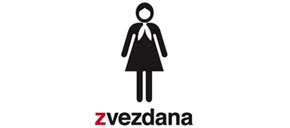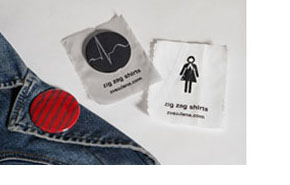 |
Zvezdana, my namesake brand, unfolded from Buy*Product, Ellen Lupton’s product-making workshops, which put to practice the idea of designers becoming independent producers. Challenged to create a line that would merge my interest in design, art, and writing, and would provide me with a possible link to the design industry in Eastern Europe, to which I have native ties, I created The Zig Zag Shirts, my debut fashion collection. |
 |
 |
The Zvezdana logo, consists of the exotic combination of foreign-sounding consonants, perfect for a brand of transnational, post-ethnic style, and a mark from Resident Aliens, a series of pictograms I created as a visual elaboration on notions of ethnicity in contemporary society. In the 1930’s Otto Neurath developed Isotype (International System of Typographic Picture Education), a library of pictograms he intended for creating narrative through visual symbols, without words, and without any non-essential characteristics. The stripped-down “man” and “woman” symbols, ubiquitous on present-day bathroom doors and airport signs, draw on Neurath’s legacy, and were the starting point for my project, which aimed to reinvest the seemingly universal figures with signifiers of ethnicity, such as a head scarf, sombrero, or a turban. Resident aliens, one of the official terms for foreigners residing legally in the US, carry subtexts, additional narratives that my brand points to, embellishes, and turns into style. |
|
Having lived through the Balkan conflicts of the 1990’s, I saw how wars were fought over language just as much as they were over land or economic privilege. While industries were shutting down, language was amplified in political media campaigns, yet silenced in the mouths of those who found it inadequate to express tragedy and loss. Further, in the consequent brain-drain – the exodus of young professionals to the West – people found themselves amidst foreign languages, in which communication and understanding became even more fractured. In designing the Zig Zag Shirts, I chose to sidestep formal language and developed decorative patterns out of a non-verbal indication system – the EKG (electrocardiogram) and other medical grams. These patterns, taken out of their medical context, and machine-embroidered over the heart on button-down shirts, make a definitive statement on behalf of each wearer, a narrative about his or her proverbial “heart rate,” and thereby create communication through graphics and fashion. In creating a product that “speaks”, I symbolically posed an alternative to the communications gap left gaping in post-communist Eastern Europe. |
 |
The Buy*Product Christmas sale at MICA spawned a flurry of local opportunities: I participated in Momi Antonio’s Urban Design Showcase, the TransModern Age show organized by Rebecca Alvania and Jackie Milad, and a group interview by the City Paper on fashion in Baltimore. Zig Zag Shirts were placed in the Shine Collective, a reknowned local boutique. An article in Urbanite Magazine led to a promotion offer by the Maryland Film Festival, and possible involvement with FashionScape and Fashion on Charles in coming months. Inspired by Laurel’s Utopian Entrepreneur, and intent on broadening my target audience, I researched ways of making an economic link to the Balkans. I have been negotiating with Azzaro, a Belgrade-based shirt manufacturer and distributor with 40 stores throughout Eastern Europe. The company is interested in producing and marketing my collection in Europe, as well as supplying a quantity of shirts for my sales in the US. A partnership of this sort can serve as a model for future fruitful collaborations between independent designers and manufacturers in the US and Eastern Europe. |
|

